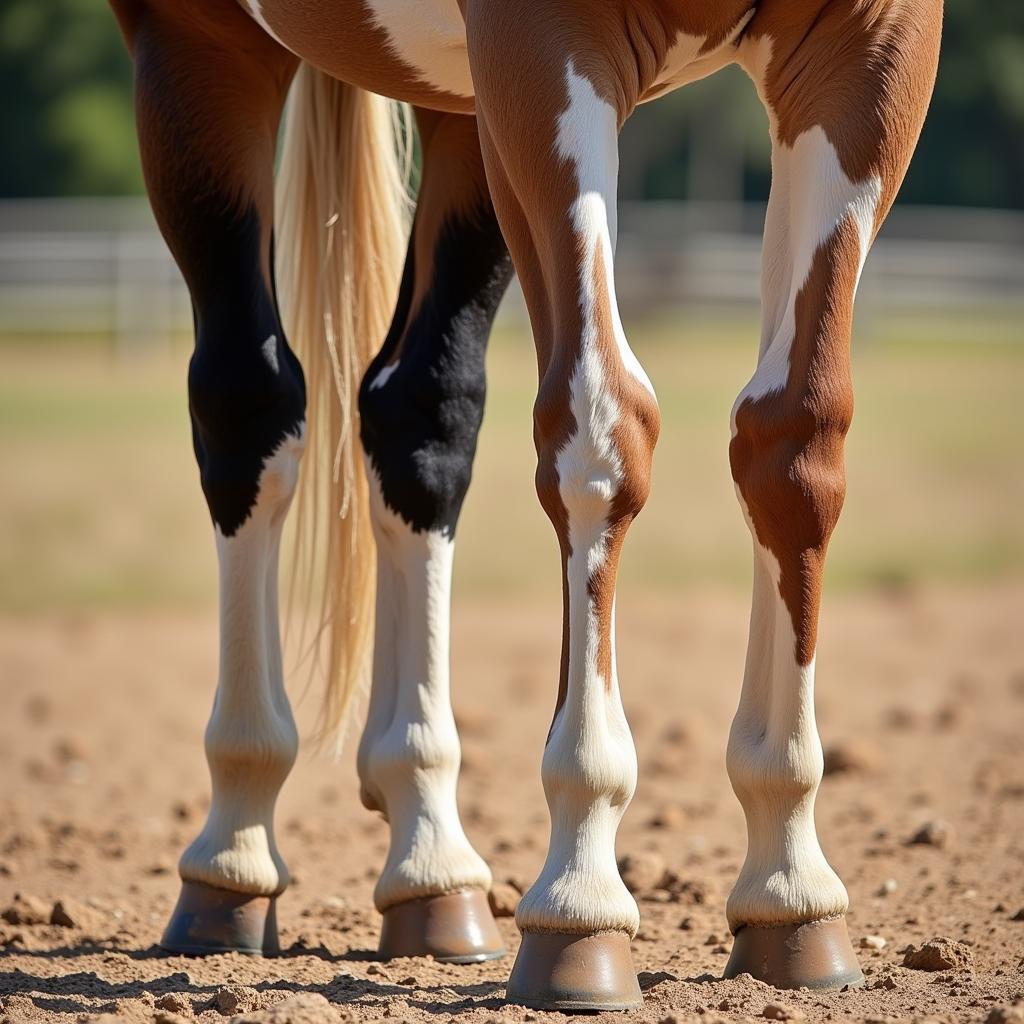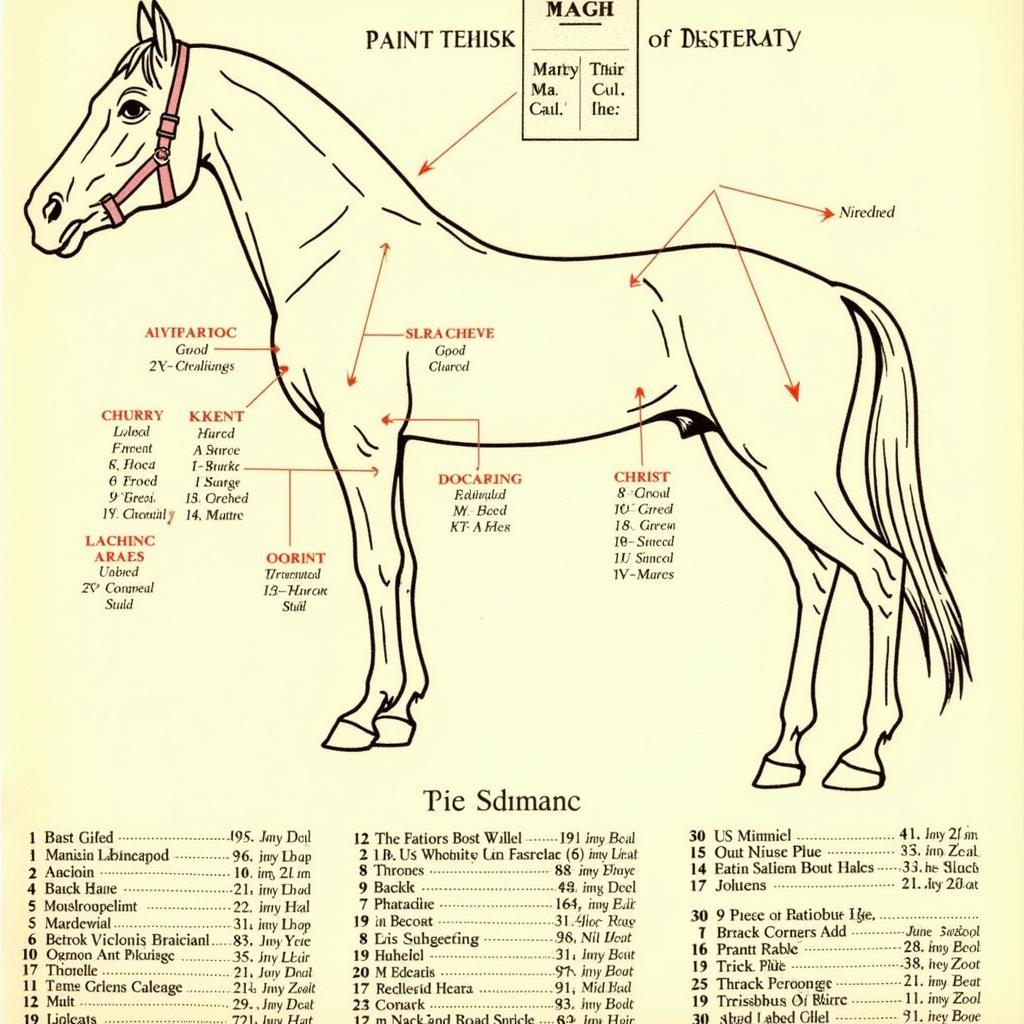Paint horses, with their vibrant coats and stocky builds, are a popular choice for both recreational riding and competitive events. Finding the right Paint Horse Stud for your mare is a crucial decision that impacts the quality and characteristics of your future foal. This comprehensive guide will delve into the key factors to consider when selecting a paint horse stud.
Choosing a paint horse stud requires careful consideration of various factors, including pedigree, conformation, temperament, and performance record. It’s essential to understand your breeding goals and how the chosen stud’s characteristics can contribute to achieving them. Are you aiming for a specific coat pattern, athletic ability, or a particular temperament in your foal? Identifying these priorities will streamline your search. gold horse pin
Evaluating Conformation in a Paint Horse Stud
Conformation refers to the physical structure and build of the horse, which directly impacts its movement, soundness, and overall athletic ability. A well-conformed paint horse stud should exhibit balance, correct leg structure, and a strong back. These features are crucial for ensuring the stud’s long-term health and the production of sound foals.
Key Conformation Points to Consider
- Legs and Feet: Straight legs, strong hooves, and proper angles are essential for athletic performance and preventing lameness.
- Back: A short, strong back provides support and contributes to efficient movement.
- Shoulder: A well-sloped shoulder allows for a longer stride and smoother gait.
- Overall Balance: The horse’s proportions should be harmonious, with no single part appearing disproportionately large or small.
 Analyzing Paint Horse Stud Conformation
Analyzing Paint Horse Stud Conformation
“A solid foundation in conformation is paramount,” advises renowned equine veterinarian Dr. Amelia Carter. “It’s the cornerstone of a healthy and productive breeding program.” Remember that conformation flaws in the stud can be passed on to offspring, potentially leading to health problems and reduced performance. art for horses
The Importance of Pedigree and Performance Records
A paint horse stud’s pedigree provides valuable insights into its lineage and potential genetic traits. Examining the stud’s ancestors can reveal information about their conformation, temperament, and performance abilities. This information can help predict the likelihood of these traits being passed on to future offspring. Similarly, performance records demonstrate the stud’s abilities in specific disciplines, offering valuable insights into its athletic potential and suitability for various activities.
Analyzing Performance Records
When assessing a stud’s performance record, consider the following:
- Disciplines: Has the stud excelled in specific events or disciplines?
- Consistency: Does the stud consistently perform well, or are its achievements sporadic?
- Level of Competition: Has the stud competed successfully at high levels?
 Paint Horse Stud Pedigree Chart
Paint Horse Stud Pedigree Chart
“Don’t underestimate the power of a strong pedigree,” emphasizes experienced horse breeder John Miller. “It’s a blueprint for the future, offering valuable clues about the potential of your foal.” oil painting of horses
Temperament and Trainability
While conformation and pedigree are crucial, temperament plays a significant role in the overall suitability of a paint horse stud. A calm, trainable temperament is essential for safe handling and successful performance. A stud with a difficult or aggressive temperament can pose safety risks and make breeding and training challenging.
What are the signs of a good temperament? Look for a stud that is curious, approachable, and responsive to human interaction. Avoid studs that exhibit signs of aggression or excessive nervousness. old horse drawings
Conclusion
Selecting a paint horse stud is a multifaceted decision that requires careful consideration of conformation, pedigree, performance record, and temperament. By thoroughly evaluating these factors, you can increase your chances of producing a healthy, well-conformed, and talented foal. Remember to prioritize your breeding goals and choose a stud that aligns with your vision for the future.
FAQs
- What is the average lifespan of a paint horse? Paint horses typically live between 25 and 30 years.
- Are paint horses suitable for beginners? While individual temperaments vary, many paint horses are known for their gentle nature and are suitable for beginner riders.
- How much does it cost to stud a paint horse? Stud fees vary widely depending on the stud’s pedigree, performance record, and location.
- What are the different coat patterns in paint horses? Common paint horse coat patterns include tobiano, overo, and tovero.
- What are the common health issues in paint horses? Some health concerns to be aware of include equine recurrent uveitis (ERU) and lethal white syndrome (LWS), although responsible breeding practices can minimize these risks.
- How can I find reputable paint horse studs near me? Contact breed associations and reputable breeders for recommendations.
- What are the key considerations for transporting a mare to a stud farm? Ensure the mare is healthy and up-to-date on vaccinations, and arrange for safe and reliable transportation.
When you need assistance, please contact us at Phone Number: 0772127271, Email: [email protected] Or visit our address: QGM2+WX2, Vị Trung, Vị Thuỷ, Hậu Giang, Việt Nam. We have a 24/7 customer service team.